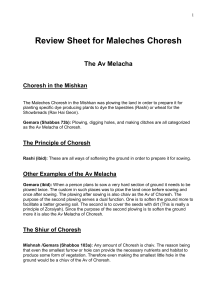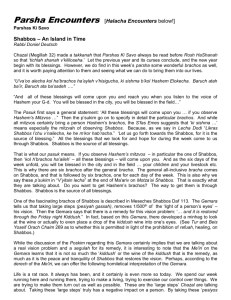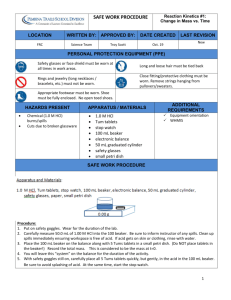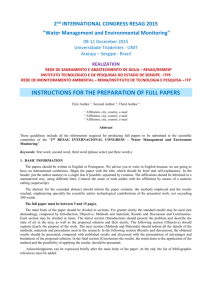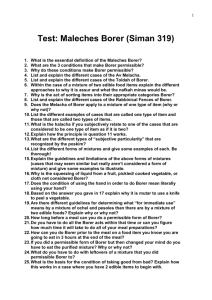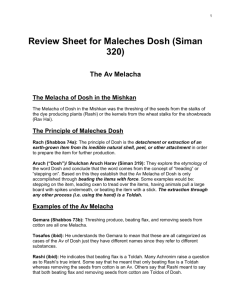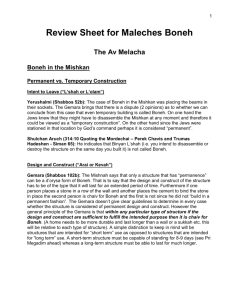Maleches Tzovaiyah
advertisement
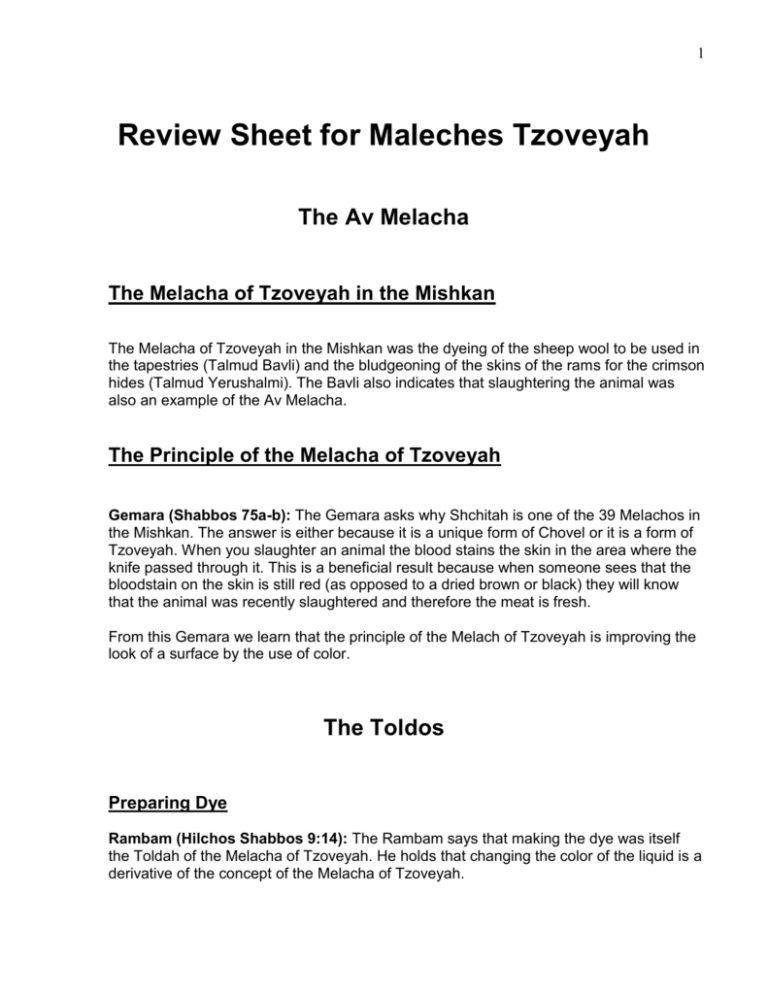
1 Review Sheet for Maleches Tzoveyah The Av Melacha The Melacha of Tzoveyah in the Mishkan The Melacha of Tzoveyah in the Mishkan was the dyeing of the sheep wool to be used in the tapestries (Talmud Bavli) and the bludgeoning of the skins of the rams for the crimson hides (Talmud Yerushalmi). The Bavli also indicates that slaughtering the animal was also an example of the Av Melacha. The Principle of the Melacha of Tzoveyah Gemara (Shabbos 75a-b): The Gemara asks why Shchitah is one of the 39 Melachos in the Mishkan. The answer is either because it is a unique form of Chovel or it is a form of Tzoveyah. When you slaughter an animal the blood stains the skin in the area where the knife passed through it. This is a beneficial result because when someone sees that the bloodstain on the skin is still red (as opposed to a dried brown or black) they will know that the animal was recently slaughtered and therefore the meat is fresh. From this Gemara we learn that the principle of the Melach of Tzoveyah is improving the look of a surface by the use of color. The Toldos Preparing Dye Rambam (Hilchos Shabbos 9:14): The Rambam says that making the dye was itself the Toldah of the Melacha of Tzoveyah. He holds that changing the color of the liquid is a derivative of the concept of the Melacha of Tzoveyah. 2 Ravad (ibid): The Ravad disagrees with the Rambam and says that since adding the dye material to the water was only a preliminary stage of the actual making of the dye it is not considered Tzoveyah. The change of the water was merely preliminary and served no real purpose in the dyeing process. After the colored liquid was made they would let the entire cauldron dry out until all that was left was a hard concentrated “brick” of dye. This dye was then taken and remixed with water to make the dye that would actually be used. The rewetting of the dye was included in the Melacha of Losh. The Difference Between Kosev and Tzoveyah It is crucial to understand the difference between the Melacha of Kosev and the Melacha of Tzoveyah. Both of these Melachos involve making impressions on a surface however in principle they are fundamentally different. Kosev involves the creation of a meaningful symbol. It is of no consequence whether the surface you write on is improved as a result of this symbol or not. For example gouging ones initials into a tabletop may ruin the table but it is still Kosev. Furthermore regarding the Melacha of Kosev the creation of the symbol is itself the significant act whereas the surface is merely the place where the symbol happens to be resting. Tzoveyah on the other hand is almost the exact opposite. The Melacha of Tzoveyah is the beautification or enhancement of the look of a surface. If through the use of color the look of a surface is improved it is the Melacha of Tzoveyah. Color itself is not a meaningful message or symbol but rather the surface has its own importance. In Tzoveyah you are enhancing the inherent importance of the surface itself. *As a result if a person were to draw a picture on a piece of paper it would be the Melacha of Kosev since the picture or symbol is the significant act. The fact that the paper may look better as a result is merely coincidental. If you would subsequently color the picture you would then be transgressing Tzoveyah since you are enhancing the look of the surface itself. Permanent Vs. Non-Permanent Tzoveyah There is a general rule that applies to the 39 Melachos that anytime the Melacha is nonpermanent in nature then it is not classified as a Melacha m’dorysa. Of course this act is still Rabbinically prohibited. 3 A Coloring that is Easily Wiped Away Rambam (Hilchos Shabbos 9:13): One example of Tzoveyah that is Non-Permanent is coloring a piece of metal with Serak (a red paint/ crayon like coloring). This is nonpermanent Tzoveyah because although it clings to the metal it is easily wiped off. *Even though applying a color that is easily wiped off is Tzoveyah m’derabanan nevertheless this is only because there is some level of adhesion of the color to the surface. If in fact there is no adhesion at all then of course the surface was not changed by color at all and it is not Tzoveyah. An example of this would be laying a piece of construction paper on a table top. A Color that Will Fade Away After a Short Time Rambam (Hilchos Shabbos 22:23): Here he says that it is assur m’derabanan for a woman to put on makeup on Shabbos since this is a non-permanent Tzoveyah. After a few hours the makeup fades away and leaves no impression. The poskim discuss what the amount of time is in order to determine whether the act is Permanent or Non-Permanent Tzoveyah. Shar Hatziun (303:68): He has a doubt as to where to draw the line on this issue. Either the color must last for the duration of Shabbos or for ever. From this presentation of the issue it would seem that color that fades away after a few hours is considered NonPermanent. Minchas Chinuch (Mesech Tzoveiyah): He brings a proof from the Rambam that even a color that lasts more than a few hours is already considered Permanent. A Natural Color Change Rav Moshe Feinstein (Orach Chaim 3 Res. 45): He says that if the coloring process is constantly in flux due to natural factors it is mutar since this does not even amount to a Semi Permanent coloring. His rationale is that since the color change is a natural process that is constantly in flux there is no halachic significance to the color change. Rav Shlomo Zalman Auerbach: He qualifies that this heter of Rav Moshe can only apply to situations where in fact the color change is indirect. However if you do a direct act to cause the color change and you desire the color change then it is assur m’derabanan as a Non-Permanent Tzoveyah. Based on this Rav Shlomo Zalman says that it is assur to use a type of thermometer that changes colors when applied to the forehead. 4 *Another possible nafkah minah between these two opinions is by a baby spoon or cup that is designed to change colors when it is too hot. If you desire this change in order to protect your child from getting burned it could fall under the issur d’rabanan mentioned by Rav Shlomo Zalman Auerbach. Surfaces Applicable to Tzoveyah Metal Rambam (H.S. 9:13): There we saw that if not for the fact that the colorful substance you are putting on the metal was easily wiped off it would be a Melacha d’orysa of Tzoveyah. Textiles Bavli/ Yerushalmi (see above in the Mishkan): From these Gemaros we learn that the Melacha of Tzoveyah is applicable to soft pliable and absorbent substances like skin or wool fibers. Liquids Rambam (H.S. 9:14): From this halacha we learned that even changing the color of a liquid is potentially the Melacha of Tzoveyah. In this case even the Ravad might agree in principle just the case the Rambam was using was controversial. The Quality of the “Color Enhancement” Changing the Essential Color of the Item Yerushalmi/ Rambam (H.S. 9:14): From these examples of the bludgeoning and the dyeing the water it is clear that completely changing the essential color of the item is Tzoveyah. 5 Adding a Layer of Color to the External Surface of an Item Rambam (H. S. 9:13): From these words it is clear that even adding an external layer of color is Tzoveyah. Enhancing the Existing Color of a Surface Mishnah Brurah (327: 12): Even applying a clear gloss coat to an item like oil to leather shoes is Tzoveyah since although you aren’t adding a new color you are enhancing the existing color. Derech Lichluch in Tzoveyah There is a debate amongst the poskim whether or not the heter of derech lichluch applies to the Melacha of Tzoveyah. Radvaz: He says that just like we say that there is a heter of derech lichluch by the Melacha of Melabein so to there is such a heter by Tzoveyah. It is easy to understand the heter of derech lichluch by Melabein since the dirtying effect is the antithesis of the Melacha. On the other hand by Tzoveyah it is less pashut since although the garment or surface as a whole is dirtied nevertheless the effects of the dying on the isolated area are genuine. Nevertheless the Radvaz says that derech lichluch is mutar by Tzoveyah since the overall effect on the item is destructive not constructive. Magen Avraham (320:24): He disagrees based on the fact that even by Melabein there are some opinions that derech lichluch is not a heter. Adding that together with the fact that by Tzoveyah the concept of derech lichluch is less contradictory to the concept of the Melacha itself he concludes that derech lichluch is assur by Tzoveyah. Mishnah Brurah (320:59): He poskins that a person can rely on the opinion of the Radvaz when it is not possible to do the act any other way. In a case where a person is relying on the heter of derech lichluch there is a question as to whether he should use a garment that is a different color than the substance you are wiping or a similar color. Magen Avraham (320:25): He says that using a similar colored garment is even worse than using a contrasting color since you are strengthening and enhancing the color on that area of the garment. 6 Eliyah Rabbah (ibid): He contends the opposite that in fact it is better to use a similar color to perform a derech lichluch type of Tzoveyah since the dying effect is altogether less significant. Mishnah Brurah (320:59): He poskins like the Magen Avraham on this issue. Derech Lichluch with Disposable Items Rav Shlomo Zalman Auerbach: He says that the entire halacha of derech lichluch is referring to using a garment that you wish to keep and preserve. However any time you are using a disposable item (like paper) to wipe a dirty surface with, then the entire Melacha of Tzoveyah doesn’t apply since the effects are of little consequence as you plan to throw the whole thing away after this use. (Of course it is still assur m’derabanan to dye a paper napkin in order to beautify it and thus preserve it) Common Applications of Tzoveyah Polishing Shoes Mishnah Brurah (327:12): It is assur to apply shoe polish to a shoe on Shabbos due to the Melacha of Tzoveyah. This is true even when just applying oil that will enhance the present color of the shoe even though it doesn’t add new color. (It should be noted that thick shoe polish is assur to apply on Shabbos due to the Melacha of Memacheik as well). Buffing or Shining Polished Shoes Rav Shlom Zalman Auerbach: Even if liquid polish was applied before Shabbos and you are merely buffing the shoes on Shabbos this is also included in the issur of Tzoveyah since you are deepening and enhancing the present color. Toilet Deodorizers Piskei Teshuvos: He brings down a number of prominent T’shuvos Sefarim that permit the use of these flush dispensers on Shabbos since the entire act is a form of Grama (indirect) and furthermore the water many times only reaches the dispenser after filling the bowl which is an additional form of indirectness. 7 Rav Shlomo Zalman Auerbach (S.S.K. 23:14 note 44): He disagrees and says that this act is classified as Tzoveyah since you have intent to color the water. It is therefore comparable to the case mentioned above in Mishnah Brurah about putting food coloring in a bowl of water and placing it in the window. Lemaseh: In order to avoid a possible issur Shabbos most leading Poskim say that a person should remove these flush dispensers before Shabbos. All the more so a person should not insert one of these dispensers lechatchilah on Shabbos. If the Deodorizer Wasn’t Removed Before Shabbos Rav Shlomo Zalman Auerbach: He permits flushing the toilet in such a situation since the alternative (leaving the toilet unflushed) is offensive to human dignity. Orchos Shabbos: He brings down that it is actually preferable to kick the dispenser out with the foot or (if this will lead to a disgraceful situation) take it out with the hand. Even though the dispenser is Muktzeh Machmas Gufo nevertheless using the foot to move Muktzeh is never assur. Furthermore if kicking it will lead to a disgrace then the Rabbis waved the issur Muktzeh in case of human disgrace. Tzoveyah in Foods Shulchan Aruch (320:19-20): It is mutar to add colorful substances to food since the Melacha of Tzoveyah doesn’t apply to foods. The poskim question why this halacha should be so. Sefer Hayeraim: The source of this halacha is from this Rishon and the indication is that the Melacha of Tzoveyah doesn’t apply to food because it is not a substance that is normally dyed. As a result the effect of the dye is completely inconsequential. Pri Megadim: In fact the Pri Megadim explains this way in the Shulchan Aruch. According to him it would be mutar to add colorful substances to food even if your entire kavanah is just to change the look of the food and nothing else. Nishmas Adam: He disagrees with this explanation and says that the reason food is exempt from Tzoveyah is only because food is generally something that is eaten and as a result it is not so important that it should look a certain way. Of course if the entire purpose of adding a colorful substance to your food is merely to enhance the look and doesn’t affect the taste in any way then it would be assur. 8 Mishnah Brurah (320:56): He poskins that the ikar hadin is like the Pri Megadim. However in a case where your entire kavanah is just for the look and not the taste at all then it is kedai to be machmir for the Nishmas Adam. In addition according to everyone it is assur to put food coloring in a bowl of water in order to place it in the window for decoration. Even though this involves the use of water since you don’t have any interest in drinking the water then it is Tzoveyah m’dorysa. The Chafetz Chaim brings down that there is an opinion in the Rishonim that holds that all coloring of food is assur even if you are enhancing the flavor and your intention is solely to enhance the flavor. (This is of course not like the halacha in Shulchan Aruch) Shar Hatziun (318:65): He says that if it is possible it is nice to try to fulfill this opinion as well. Therefore when making tea from essence on Shabbos if the essence is hot then you should pour it in the glass first and then the hot water since this way you are merely lightning the color of the essence as opposed to coloring the water with the essence. Beauty and Cosmetics The Nature of the Issur Mishnah Brurah (303:79): Regardless of the cosmetic treatment being used Tzoveyah on the skin of a person is always m’derabanan since you never intend to leave it there and the entire act is one of “Non Permanent in nature. *(It is important to note that there are some opinions that hold that cosmetic applications may even be considered Tzoveyah m’dorysa since this is the normal thing for a woman to do) Applying Cosmetics to Another’s Face Biur Halacha (303:25 Meshum Tzoveyah): It is certainly assur at least m’derabanan for someone to apply cosmetics to another persons face on Shabbos. Many times this type of coloring is more effective since the one applying the makeup has more control and access to the face of the one whom they are applying it to. 9 Specific Cosmetic Applications Rouge, Eyeliner, and Mud Shulchan Aruch (303:25): It is assur for a woman to apply rouge, eyeliner, or mud to the face (in order to deepen the natural color). Non Oil Based Powder (Even White or Skin Color) Rav Moshe Feinstein (Orach Chaim 1 Res. 114): It is mutar for a woman to apply a non-oil based powder to the face since this is tantamount to placing a piece of construction paper on a table top. Shmiras Shabbos Kehilchasa (Ch. 14 Note 158): He disagrees and says that this is not the case. In fact these powders have some minimal adhesive qualities and therefore since the woman applies them with a direct act and she has clear intent to color the face therefore these powders are assur. Oil Based Powders Until now we were referring to powders that do not have an oil base however there are many types of powder on the market that contain an oil base and are very adhesive to the extent that they need to be remove with soap and water or other methods. S.S.K (ibid.): These types of powders are definitely assur to use on Shabbos since they have a much stronger adhesiveness. Even Rav Moshe Feinstein would seemingly agree to this halacha. Lipstick or Lip Gloss Shulchan Aruch (ibid.): The issur to use colored lipstick or lipgloss would be included in the issur to put rouge and eyeliner on the face as mentioned before. *It is important to note that a hardened stick of lipstick is also assur to apply on Shabbos due to the Melacha of Memacheik. We are adding here that even the liquid version of lipstick or lipgloss is assur to use on Shabbos since these items color the face. 10 (Clear Lip Gloss) Rav Shlomo Zalman Auerbach (quoted in S.S.K. Ch. 14 note 155): He adds that even clear lipgloss is still Tzoveyah since either it is a color in and of itself or at least serves to enhance the natural color of the lips. This is based on the Mishnah Brruah mentioned above. Cover Up Creams It follows from the above principles that cover-up creams or any similar type of product are also assur to use on Shabbos even if they are not thick enough to pose a problem of Memacheik. The reason these items are assur is because they serve to color over the blemished or darkened skin with a “natural looking” cream color. This is similar to the principle of Tzoveyah mentioned above. Nailpolish Shulchan Aruch (ibid.): Many contemporary Poskim learn out from this Shulchan Aruch that the use of nail polish is also Tzoveyah. Clear Nail Gloss Rav Shlomo Zalman Auerbach (S.S.K. Ch.14 note 152): He adds that even a clear nail gloss is Tzoveyah since either it is a color on its own or serves to enhance the natural color of the nails. This is based on the Mishnah Brurah mentioned above. Pinching the Cheeks Mishnah Brurah (320:58): It is assur for a woman to pinch her cheeks excessively in order that they should have a more reddened look for some time. This is only assur for a woman because it is considered normal for her to redden her skin through other methods (i.e. makeup). Suntanning Minchas Yitzchak Vol. 5 Res. 32): He says there that it is assur on Shabbos for a person to go outside and sit in the sun with the express intent of getting a suntan. Rav Shlom Zalman Auerbach: He disagrees on two counts. For one suntanning is not “derech tzviyah”. That is to say that you are not coloring a surface in the normative 11 sense. Secondly the effects of the coloring are not visible until some time later. As a result this is mutar on Shabbos. Shmiras Shabbos Kehilchasa Ch. 18:note 70): According to everyone a person may walk outside and go about his matters out in the sun without fear that he is getting tan. This is mutar even if a person has the thought that he would be happy to get a tan. The rationale is that the entire Melacha of Tzoveyah is only applicable if you are actually doing a direct act through which you wish to color a surface. In this case the entire tan is coming by way of indirect means and involves no direct act from the person. This act therefore lacks definition as a “Creative Act”. (This rationale explains why Rav Shlomo Zalman even permits going out in the sun to sit and specifically get a tan. The stringent opinion says that in such a case this is viewed as a “direct act” of Tzoveyah and one must refrain)

